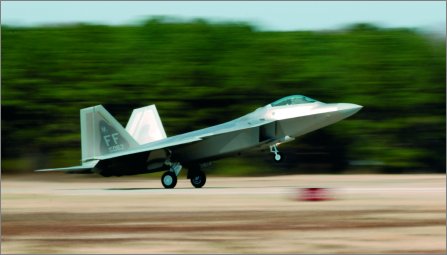Air Force and Navy pursue lower Raptor and Osprey programme costs in effort to keep within spending constraints
Negotiations are beginning on the multi-year procurement of the Lockheed Martin F-22 Raptor stealth fighter and Bell Boeing V-22 Osprey tiltrotor transport, with manufacturers and customers hoping cost savings will extend production beyond current plans.
|
Second operational unit gets first F-22 as USAF looks to extend production |
Convincing Congress to approve multi-year contracts is the biggest hurdle faced by both programmes. The US Air Force has already come under criticism for its plan to forgo procurement of F-22s in fiscal year 2007 and to stretch production of the remaining 60 aircraft planned over a three-year contract from FY08 to FY10.
Even Lockheed is unclear on how the USAF plans to bridge from the budgeted procurement of 24 F-22s in FY06 to the first 20 aircraft of a multi-year purchase in FY08. “We will still be making aircraft,” the company says.
The air force is seeking money in FY07 to produce F-22 subassemblies, but no complete aircraft, as it tries to keep the line open until availability of the Lockheed F-35 Joint Strike Fighter is assured. “We needed to stretch out and not let go of this aircraft until we got the F-35,” air force secretary Michael Wynne told Congress.
With procurement of the F-22 limited to 183 aircraft by the Department of Defense, savings from a multi-year procurement are critical.
The same is true for the V-22, with the DoD capping the programme cost at $3.1 billion below US Navy estimates. “The only way to meet that is through multi-year procurement,” says V-22 programme manager Col Bill Taylor.
The plan is to procure 159 MV-22s for the US Marine Corps and 26 CV-22s for USAF special operations over five years from FY08 to FY12.
Rather than stretching out production, the plan is to ramp up from 11 aircraft in FY06 towards the goal of 48 a year. Bringing down the V-22’s unit cost will be critical to winning Congressional approval and is “inextricably linked” to multi-year procurement, says Taylor.
“Over the last four lots we have driven down unit recurring flyaway cost by over $1 million versus the previous lot, and in each case we have beaten the target price by $1 million,” says Taylor. Lot 10 aircraft procured in FY05 cost $69.9 million each, he says, but Bell Boeing has set a target of $58 million.
GRAHAM WARWICK / WASHINGTON
Source: Flight International

















